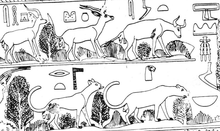Abi (Egyptian mythology)
| Abi / Aba in hieroglyphics | |||||||
|---|---|---|---|---|---|---|---|
| Middle realm |
|
||||||
| New kingdom |
|
||||||
| Gr.-Roman. time |
Abi / Aba 3bj (female) panther |
||||||
Abi (also Aba ) is an ancient Egyptian god of the dead that has been documented since the Middle Kingdom .
background
Middle realm
In the coffin texts of the Middle Kingdom, the idea is attested that the deceased in the duat takes the form of a panther. A picture of the goddess Mafdet can be seen on a “magic knife”, referring to the panther's solar and heavenly character. The phase of the sun's course can be seen on it. The entire composition including the panther head ends in the wings of an unrecognizable being. Egyptologists therefore locate the action in the body of the sky panther.
At around the same time, reference is made for the first time to the female panther, which in the Old Kingdom can still be seen as the “ divine panther giving birth ” ( Netjeret Pehet ) on the relief in the world chamber of the solar sanctuary of Niuserre .
New kingdom
In the New Kingdom , the protective function of the deity Abi also comes to the fore. The claws ( anut ) of the divine panther Abi “are on the deceased” and thereby protect him from the forces of evil.
Greco-Roman time
With the beginning of the Greco-Roman period , Abi was initially a manifestation of both Anubis and Nephthys . The history of the origins of the protective function of the panther skin is directly related : In the early days, the Sem priest is said to have used the panther skin as a magical protective function, as Seth turned into a heavenly panther while fleeing from Thoth and Anubis, who was then caught and burned has been. With the creation of the withdrawn Imiut of the panther, the danger from Seth is averted.
See also
literature
- Elmar Edel : About the inscriptions on the seasonal reliefs of the “World Chamber” from the Niuserre solar sanctuary. In: News from the Academy of Sciences in Göttingen. No. 8, Vandenhoeck & Ruprecht, Göttingen 1961, p. 244.
- Christian Leitz u. a .: Lexicon of the Egyptian gods and names of gods . Vol 1: 3-y. Peeters, Leuven 2002, ISBN 2-87723-644-7 , p. 10.
